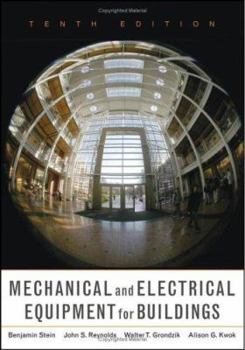Mechanical and Electrical Equipment for Buildings
Select Format
Select Condition 
Book Overview
The definitive guide to environmental control systems, updated with emerging technology and trends The Interactive Resource Center is an online learning environment where instructors and students can... This description may be from another edition of this product.
Format:Hardcover
Language:English
ISBN:0471465917
ISBN13:9780471465911
Release Date:November 2005
Publisher:Wiley
Length:1724 Pages
Weight:6.10 lbs.
Dimensions:2.3" x 7.9" x 10.1"
Customer Reviews
6 ratings
this is great book
Published by rick elliott , 2 years ago
very fast delivery
Mechanical and Electrical Equipment for Buildings
Published by Thriftbooks.com User , 16 years ago
As a resource librarian in a mid-size design (architecture) firm, building and maintaining a reference library is one of my responsibilities. I normally wait until I get a request for a book before I review it for inclusion since there is so little space for "real" books. This book was requested so that a designer could study for her registration exam. She gave it a glowing review and said it had been mentioned on the exam blogs as one of the must-reads. It also seemed to have, in one place, all the information a practicing architect would need to design with or around mechanical systems, as well as provide the framework and vocabulary to talk to consultants.
Weighty tome shows how engineering intersects architecture
Published by Thriftbooks.com User , 17 years ago
This almost 1800 page treatise on mechanical and electrical design as it relates to architecture is one of a kind. It is not an artistic book on the subject, although some artistic ability is always needed in any aspect of building design. Instead it is a very technical book that shows how the architect must be part electrical engineer, mechanical engineer, electrician, physicist, plumber, safety specialist, and transportation engineer in order to design the modern building. And to top it all off, you need to be knowledgable of current mechanical and electrical equipment - their specifications and their costs. The book has plenty of examples with step by step instructions on how to perform various subtasks. Many of these examples contain numerical calculations, so it will help if you have had freshman engineering physics, especially in the sections on illumination, acoustics, and electricity where calculations, tables, and equations abound. The book is broken into nine parts encompassing nearly every technical decision involved in designing a modern building. The first section is an introductory one on the context of design. That is followed by sections on thermal control, illumination, acoustics, water and waste, fire protection, electricity, signal systems, and finally in-building transportation. A lengthy appendix contains a great deal of supplemental information, including climate data for various parts of the United States, solar geometry, sound transmission data, and a listing of software that can be helpful in performing the tasks discussed in this book, and how that software can be obtained. I highly recommend this book to aspiring architects and also to civil engineers that are interested in the construction of modern buildings. It's been the flagship book on the subject for seventy years in its various editions, and probably will continue to be so for the foreseeable future.
The times, they are a-changin'
Published by Thriftbooks.com User , 18 years ago
This book has been an essential textbook for architectural students, and reference for professionals since its first edition in 1935. Those already familiar with its earlier editions understand this book's importance - there is no other like it at all. It is by far the most complete and thorough reference on its subject. But the impressive thing about the new (10th) edition is how transformative and transformed it is. On one hand, it should be expected that a reference on mechanical and electrical systems is a constantly changing object. Codes are always being revised, mechanical systems introduced, new lighting types invented. Photovoltaics, for example, now merit an entire chapter. Electrical code changes require revisions throughout existing chapters. And so forth. But on the other hand, in addition to the "updating" of the material, there is considerable rethinking in this edition to building systems as an essential part of sustainable design. Mechanical systems in the book consume fossil fuels, in their use or at least in their creation. The book makes this a central theme. There is a sensitivity toward environmental issues in this book which is simply wonderful to see. The book presents a strong argument for environmentally responsible design as now being solidly a mainstream, intelligent approach to building.
MEEB Bow Down
Published by Thriftbooks.com User , 18 years ago
If you want to know more than most Architects and Engineers about how to design the guts of buildings this is the book to use. It's a fat guy though! Sometimes the text seems to weigh you down. Most architectural students consider it a sloug! But, once they graduate, they use it throughout their careers as design professionals. If you want to know how to develop a regional climatic response strategy for your building or development, calculate passive ventillation rates or heat gains and losses on unique configurations of wood, siding and insulation; size gutters or a rain water catchment system or plan for an elevator, this is the book for you.
Top Notch Reference
Published by Thriftbooks.com User , 24 years ago
This volume is one of the best reference materials available for the MEP or Architectural Engineer. I found the descriptive detail and illustration that aided me in the learning process. I reccomend it highly.




